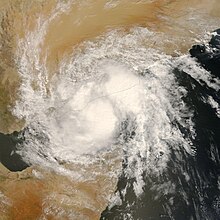 Deep Depression ARB 02 | |
| Meteorological history | |
|---|---|
| Formed | 19 October 2008 |
| Dissipated | 23 October 2008 |
| Deep depression | |
| 3-minute sustained (IMD) | |
| Highest winds | 55 km/h (35 mph) |
| Lowest pressure | 988 hPa (mbar); 29.18 inHg |
| Tropical depression | |
| 1-minute sustained (SSHWS/JTWC) | |
| Highest winds | 55 km/h (35 mph) |
| Lowest pressure | 988 hPa (mbar); 29.18 inHg |
| Overall effects | |
| Fatalities | 180 |
| Damage | $1.64 billion (2008 USD) (Second-costliest Indian Ocean cyclone on record) |
| Areas affected | Bangladesh, Myanmar, India, Sri Lanka, Thailand, Laos, China |
Part of the 2008 North Indian Ocean cyclone season | |
Deep Depression ARB 02 was a weak yet costly tropical cyclone which caused extensive damage and loss of life in Yemen. The sixth tropical cyclone and third deep depression of the 2008 North Indian Ocean cyclone season, ARB 02 formed in the Arabian Sea on October 19 from the same broader system which would spawn Moderate Tropical Storm Asma in the southern Indian Ocean around that time. Moving generally westward, the depression failed to intensify further, reaching maximum sustained winds of 55 km/h (35 mph). It would weaken, becoming a remnant low on October 23. Later that day, the system's remnants would make landfall near Ash Shihr in eastern Yemen.
The storm sent a plume of moisture throughout the Arabian Peninsula, contributing to dust storms as far north as Iraq. However, the effects were most severe in Yemen, becoming the second-worst natural disaster in the country after deadly floods in 1996. The storm dropped heavy rainfall in a normally arid region, reaching around 91 mm (3.6 in), which caused flash flooding in valleys after waterways were unable to contain the approximately 2 billion km3 (528 billion gallons) of water that fell. Poor drainage practices and an invasive species of weed contributed to the floods, which damaged or destroyed 6,505 houses, leaving about 25,000 people homeless. The floods killed 180 people and severely disrupted the livelihoods of about 700,000 residents of Hadhramaut and Al Mahrah governorates, mostly farmers whose fields were washed away. Some of the buildings at the Shibam UNESCO World Heritage Site collapsed due to the floods. Overall damage was estimated at US$874.8 million, although residual losses from damaged infrastructure were estimated to cost an additional US$726.9 million. The overall economic impact of the storm was therefore estimated at US$1.638 billion, equating to roughly 6% of the country's gross domestic product.
After the scale of the damage became clear, the government of Yemen requested for assistance from the international community. The hardest hit areas had poor infrastructure, which caused difficulties in communications as relief goods were distributed. Nations in the region, including Saudi Arabia and the United Arab Emirates, sent money and supplies to help rebuild the damaged infrastructure and houses. Agencies under the United Nations provided food and logistical support. Relief efforts continued to make progress until 2011 due to a political uprising in Yemen.